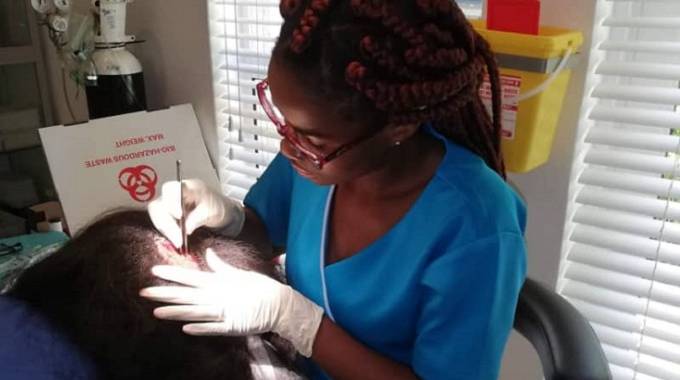A receding hairline is every woman’s nightmare

Andile Tshuma, Health
The cases of hair loss may be many, sometimes it’s genetics and hormones, sometimes it’s a result of how we take care of our hair. Whatever the reason, no one enjoys watching their edges waste.
We live in such an appearance-driven society that our looks often become one of the largest factors contributing to our self-esteem.
Because our hair is also one of the malleable aspects of our appearance, once we lose the sense of control we have over it, it’s not surprising that it has the potential to affect mood and self esteem.
Results from a street survey in Bulawayo this week showed that more women are wearing weaves and a number of women with short hair had damaged hair lines.
We now have so many shops selling all kinds of hair extensions. Some are good while others are not so good and we have both professionals and some fly by nights who will just damage your scalp and hair when you attempt to bargain for a cheaper price.
I loved box braids and I always had them extremely thick and very tight. I hated thin twists as I could not bear sitting at the salon for hours. However, with time I noticed that my hairline was receding and I had to stop.
I tried weaves, I think they were wore, I tried wigs, I could adjust, until I found myself happy with dreadlocks.
I have learnt though that I have to be wary also of how I style them as the idea is to style your hair in a way that doesn’t put much tension in the scalp.
I often have to fight with hairdressers when they want to style hair too tight for that perfect finish that doesn’t leave a single strand out of place, but after a few days you notice hairs ticking out with those white heads, that’s precious hair uprooted from the scalp. I cannot stand that.
Hair is for keeps. I’m still growing my edges back and so far I am happy as I now use natural oils and herbs for hair and some homemade concoctions.
The rule of thumb is that if a new hairstyle hurts, it’s not doing your air and scalp any good and it is better to get rid of it than to just brave the pain and lose your hair.
I can say though that it was not an easy decision going for the big chop when I shaved off all my chemical damaged hair, but it was worth it.
Over the Christmas holidays I got to engage with a South African based Zimbabwean trichologist Mrs Thuli Nxumalo, whom I love referring to as the hair doctor and she shared some of her experiences when dealing with women suffering from hair loss.
“There are so many causes but most of my patients end up suffering from depression. As it is said, hair is every woman’s crown. So some people tend to lose their confidence when hair is not at its best,” said Mrs Nxumalo.
“More women tend to seek help because hair loss is so much more devastating than it is for a man. Female hair loss has not been widely accepted by society so when female clients initially see me they are so distressed and they often break down in tears. Hair loss can have numerous causes, but the most common are hormonal, stress and nutritional,” said Mrs Nxumalo.
Having tight weaves for longer periods, over years all the styling takes its toll on the hair.
According to research Traction alopecia affects one-third of women of African descent who wear various forms of traumatic hairstyling for a prolonged period of time.
“The risk of the condition is increased by the extent of pulling and duration of traction, as well as the use of chemical relaxation. The frequent use of tight buns or ponytails, the attachment of weaves or hair extensions, and tight braids such as cornrows and dreadlocks are believed to be the highest risk hairstyles. TA can also occur in the setting of religious and occupational traumatic hairstyling. In its later stages, the disease may progress into an irreversible scarring alopecia if traumatic hairstyling and heating continues without appropriate intervention,” said Mrs Nxumalo.
The prevalence of traction alopecia remains high in communities that practise tight braiding of the hair and, especially, when “relaxer” chemical treatments are used to straighten hair of the African type.
More women of African descent are affected although the condition affects people across all races, women and men who also style their hair.
It is now generally agreed upon that the extent of pulling and the duration of traction increase the risk of the condition and that treated hair may be less resistant to traction.
During the week I got to talk to former Miss Zimbabwe Lorraine Maphala Phiri who shared on how she managed to keep her hair intact during her stint in the modelling industry.
Most women in the fashion industry tend to suffer from extreme hair loss due to a lot of styling of the hair.
One of the most popular black models, Naomi Campbell is one of the women who have been drastically affected by hair loss and she recently shared on her journey of restoring her edges.
“I was careful with the kind of hairstyles that I wore as my natural hair comes first. I must say though that I am very lucky, I have good genes as my hairline has not given me much stress, but I urge women to take good care of their hair.”
“Always use natural oils for your hair, the likes of coconut oil, castor oil and wash your hair often and wear protective hairstyles. Avoid hair that puts a lot of tension on your edges and get good quality lace wigs if you aren’t wigs and weaves, do not compromise in quality as you may be left with a bald head. Also do less of heat styling such as hair dryers, and curling irons,” said Mrs Maphala Phiri who is the Director of Real Hair by Lorraine Studio.
She urged mothers to be wary of how they style their children’s hair as some children tend to suffer from hair loss at an early age.
Some of the symptoms to look out for hair loss are that traction alopecia might show up as little bumps on your scalp that look like pimples.
As the condition progresses, the main symptom is missing and broken hairs. The hairs along the front and sides of your scalp are most often affected.
However, you may also notice hair loss on other areas of your scalp, depending on your hairstyle.
Till we meet next week, remember, Traction alopecia is reversible, but you need to treat it quickly.
If you stop wearing your hair in the tight hairstyle that caused it, your hair will grow back normally.
But if you continue styling your hair the same way, the hair loss can be permanent. No hairstyle is worth putting your scalp through all that pain because hair is for keeps.
— @andile_tshuma.











Comments